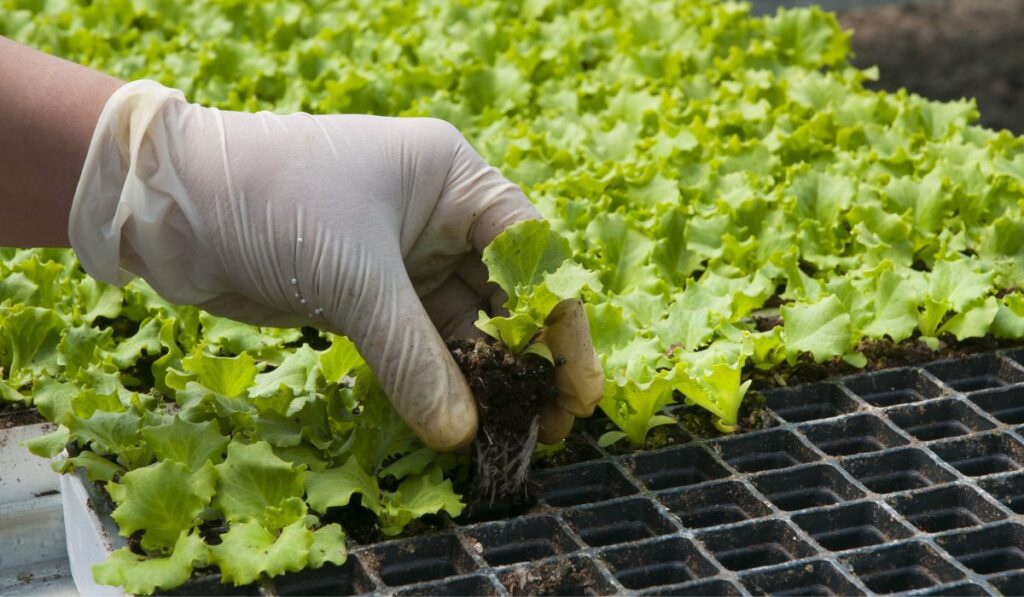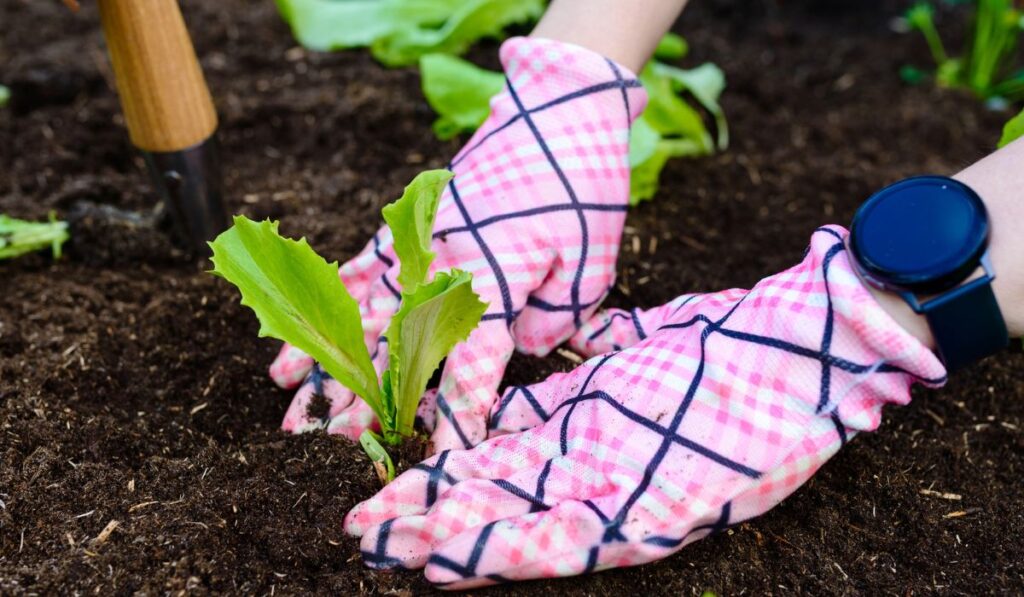Once you’ve experienced the taste of homegrown lettuce, you’ll never want to return to the store-bought kind. Luckily, lettuce is an easy crop to grow, and there are many varieties to choose from, each with a different color, shape, and size. But when is the best time to plant lettuce?
The best time to plant lettuce is in the spring, about four weeks before the last average frost or when the soil temperature is between 45˚ and 65°F. You can also grow a fall crop by planting lettuce seeds six to eight weeks before the first average frost in your area.
Lettuce doesn’t tolerate the heat well, so the growth period is pretty short. In fact, most varieties of lettuce will bolt or go to seed in hot weather conditions. But if you plan well and plant at the right time, you can have a steady supply of fresh lettuce all season. Let’s take a closer look at when and how to plant lettuce so that you can get started.
When Should You Plant Lettuce?

Lettuce is a cool weather crop, which means it grows best in the spring or fall. In most cases, you can start planting lettuce seeds as soon as the soil can be worked in the spring. This is typically 2 to 4 weeks before the last frost date in your area.
The seeds start germination when the temperature is between 45° and 65°F (7-18°C). For a continuous supply of fresh lettuce, sow the seeds every couple of weeks from late fall until early spring.
To get an early crop, you can start the lettuce seeds (on Amazon) indoors 4 to 6 weeks before the last frost date. Then transport the seedlings outdoor as soon as the temperature becomes suitable.
You can also plant lettuce in the fall, six to eight weeks before the first frost date. This will give you a crop of delicious salad greens well into the winter months. Just make sure to choose a fast-maturing variety, so you can harvest before the weather gets too cold.
However, you’ll need to do some extra preparation like mulching and shading to help seedlings during the first few hot weeks.
Can Lettuce Grow in Different Climates?
The ideal temperatures for growing lettuce are between 60° and 70°F (15-21°C). But since it’s a short-lived annual vegetable, you can adjust the planting time depending on your climate.
In hot weather climates, it’s best to plant lettuce in the fall or winter because it can tolerate chilly weather. But the leaves become hard and bitter, and the plant will bolt as soon as the temperature exceeds 70°F (21°C).
So if you’re planting in the spring or summer, choose a heat-resistant variety. Plant lettuce in a shady spot and protect it from the hot afternoon sun with the help of shade cloths (on Amazon).
It’s much easier to grow lettuce in a cool weather climate. You can plant it in the spring or fall, and it will do well even in the cooler months of winter. It can tolerate frost and even light snow, but for the best results, plant it in an area with full sun. Keep row covers (on Amazon) handy to provide protection from extreme cold weather.
The Different Varieties of Lettuce
Lettuce is categorized into four groups based on the color and shape of the leaves. Several varieties are available in each group, and you can choose the one that best suits your needs.
Let’s go through the four types and a few popular varieties of each.
Looseleaf Lettuce
As the name suggests, this type of lettuce has loose, ruffled leaves. It doesn’t make a firm head like the other types. The leaves are typically green, but you can also find red and bronze varieties. Looseheads are probably the most popular type of lettuce grown in home gardens.
It’s a cut-and-come-again type of lettuce, which means you can keep harvesting the leaves for a couple of weeks.
Some popular varieties include:
- Oakleaf: Deeply lobed, oak-shaped leaves with a clean taste. Oakleaf (on Amazon) can grow into full heads if left to mature.
- Merlot: Red to purple ruffled leaves with a crispy texture. Merlot (on Amazon) is perfect for salads and sandwiches.
- Grand Rapids: Thick green leaves, larger than average varieties. Grand Rapids (on Amazon) is slightly heat resistant and sweet.
Romaine Lettuce:
Also known as cos lettuce, this type has long upright leaves forming tight heads. The leaves can be red, green, or speckled and have a crisp texture.
Romaine lettuce is one of the most popular options for use in salads — Caesar salad is a prime example.
The taste profile is also slightly different from other lettuces; it’s not as bland but tastes slightly savory and bitter. Some popular varieties of romaine lettuce include:
- Parris Island: Light green, small leaves with a crisp texture. Parris Island (on Amazon) is an heirloom heat-resistant variety.
- Green Towers: Deeply green, tall, and slightly savory.
- Forellenschluss: A gorgeous Australian lettuce with speckled green and maroon leaves. Forellenschluss (on Amazon) has thick juicy leaves and grows well in hot weather.
Butterhead Lettuce
As the name suggests, this type of lettuce has buttery, soft, succulent leaves. The leaves are loosely packed and form small heads like flower petals.
Butterhead lettuce is revered for the freshness and sweetness of its leaves. It’s further divided into two categories based on the shape of the head:
- Butterhead Bibb: The leaves are small and round with a light green or yellow color. It tastes delicate, sweet, and almost melts into your mouth. Burpee bibb, Rex Lettuce, and Buttercrunch lettuce are some of the most popular varieties.
- Butterhead Boston: Slightly bigger than bibb, Butterhead Boston comes in the form of rosettes. The leaves are dark green and have a slightly nutty flavor, but the texture is still buttery soft. Tom Thumb, Divina, and Santoro are some of the most popular varieties in this category.
Crisphead Lettuce
These are the ones you typically find in grocery stores. The heads are round, large, tightly packed, and have a crisp texture. The leaves can be green to light green or even have a slight tinge of red or yellow.
Crisphead lettuces can take longer to mature (up to 80 days), but they’re worth the wait. Some popular varieties include:
- Iceberg: The most common crisphead lettuce. Iceberg (on Amazon) has large white-green heads with a fresh, slightly crunchy texture.
- Great Lakes: A bright green large variety, highly resistant to the sun.
- Ithaca: A beautiful heirloom variety with large, frilly leaves.
Lettuce vs. Cabbage
Lettuce and cabbage may look similar, but they’re actually quite different. For one, cabbage belongs to the Brassica family, which also includes broccoli and kale, while lettuce is from the Asteraceae family, which makes it closer to sunflowers and daisies.
This difference is reflected in their taste and texture; cabbage is a lot tougher, and it has thick leaves, dense packing, and a low water content. It also has a sharper taste that some people describe as “peppery.”
Lettuce, on the other hand, is a lot more delicate. It’s about 95% water (which is why it’s so refreshing), has a softer texture, and is sweet (some varieties may taste like nothing).
How to Grow a Lettuce Garden

Lettuce can grow in a garden bed, window boxes, pots, containers, or even fabric grow bags. And there are so many varieties that you can have a colorful and interesting garden even if you only plant lettuce. The only requirement is the right amount of sunlight and moisture. Other than that, it’s a fairly low-maintenance plant.
If you want to grow a lettuce garden, here are some key tips:
- Lettuce prefers cooler temperatures, so pick a spot with partial sun or filtered sunlight. If you don’t have an ideal space, arrange for some shade cloths to cover the plants during hot afternoons.
- Lettuce is a shallow-rooted plant, so for soil preparation, you only need to till the top 4-6 inches. Then add some compost or organic matter to the soil to help drainage and nutrients. Or add organic slow-release fertilizer (on Amazon).
- Lettuce seeds are tiny, so it’s best to use broadcast seeding or seed tapes/strips. Sow the seeds thinly and evenly, then cover them with a thin layer of soil.
- Keep the soil moist by watering regularly (use a fine sprinkler to avoid dislodging the seeds.)
- Once the seedlings emerge, thin them out, so they’re about 8-12 inches apart, depending on the variety. Make bands or rows about 18 inches apart to make harvesting easier.
- Plant a new batch every 2-3 weeks to ensure a continuous supply of fresh lettuce.
- You should be able to get your first harvest in 6-8 weeks, but it really depends on the variety. Some lettuce can take up to 80 days to mature.
How to Propagate Your Lettuce
Lettuce is usually grown from seeds, but since the plant is 95% water, it can also grow in freshwater (hydrophytes.) This way, you can have a constant supply of lettuce without replanting. Here’s how to go about it:
- Cut the lettuce bunches near the roots, and remove the leaves so you’re left with about an inch of stem.
- Fill a shallow container with fresh water and place it in a sunny spot.
- Put the stems in the water, ensuring that at least half are submerged.
- Change the water every few days to keep it fresh.
- You’ll see new leaves and roots sprout from the stem in a week or two.
- Snip off the leaves when they’re about 4 inches long.
Propagating lettuce in water may not give you the fullest heads, but it’s a great way to constantly supply fresh leaves.
Harvesting Your Lettuce
Lettuce can give multiple harvests if you follow the right method, which is different for each type of lettuce.
Crisp lettuce, for example, is harvested when the head is fully formed and tight. You can tell it’s ready when the outer leaves are crisp and have a pale green color.
You can pull the head from the ground or cut it about 1-2 inches from the ground. Some varieties, like iceberg, can give a second harvest if you leave the root in the ground.
Loose-leaf lettuce is harvested by snipping off the leaves 1-2 inches above the ground. You can selectively harvest the individual or full plant, and the remaining part will continue to grow more leaves so that you can keep harvesting for several weeks.
For butterhead or romaine types, pick the mature outer leaves first, then allow the center to grow more. You can also harvest the entire plant, and it will regrow in about a month.
Always harvest your lettuce in the morning when the leaves are crisp and full of moisture. Also, don’t leave mature heads in the garden for too long, or they’ll get bitter and woody and start bolting in high heat.
How to Protect Your Lettuce From Pests and Disease
Lettuce isn’t too susceptible to pests and disease, but there are a few common problems you might come across.
Aphids, whiteflies, and cutworms are the most common insects. You can eliminate them by spraying the plants with water or homemade insecticidal soap. They’re also very easy to avoid by growing companion plants.
The most common diseases are lettuce mosaic virus and powdery mildew. They both affect the leaves and can make them yellow, spotted, or distorted. Remove the affected leaves and destroy them if you see any of these symptoms.
You can also prevent these diseases by planting disease-resistant varieties and watering the plants at the base to keep the leaves dry. And don’t plant lettuce in the same spot every year.
Furthermore, slugs, snails, and rabbits enjoy nibbling lettuce, so you may want to keep an eye out for them too.
